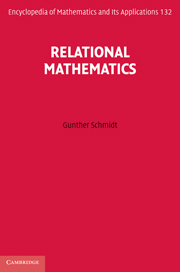Book contents
- Frontmatter
- Contents
- Notes on illustrations
- Preface
- 1 Introduction
- PART I REPRESENTATIONS OF RELATIONS
- PART II OPERATIONS AND CONSTRUCTIONS
- PART III ALGEBRA
- PART IV APPLICATIONS
- 12 Orderings: an advanced view
- 13 Preference and indifference
- 14 Aggregating preferences
- 15 Relational graph theory
- 16 Standard Galois mechanisms
- PART V ADVANCED TOPICS
- Appendix A Notation
- Appendix B Proofs postponed from Part II
- Appendix C Algebraic visualization
- Appendix D Historical annotations
- References
- Symbols
- Index
15 - Relational graph theory
from PART IV - APPLICATIONS
Published online by Cambridge University Press: 05 May 2013
- Frontmatter
- Contents
- Notes on illustrations
- Preface
- 1 Introduction
- PART I REPRESENTATIONS OF RELATIONS
- PART II OPERATIONS AND CONSTRUCTIONS
- PART III ALGEBRA
- PART IV APPLICATIONS
- 12 Orderings: an advanced view
- 13 Preference and indifference
- 14 Aggregating preferences
- 15 Relational graph theory
- 16 Standard Galois mechanisms
- PART V ADVANCED TOPICS
- Appendix A Notation
- Appendix B Proofs postponed from Part II
- Appendix C Algebraic visualization
- Appendix D Historical annotations
- References
- Symbols
- Index
Summary
Many of the problems handled in applications are traditionally formulated in terms of graphs. This means that graphs will often be drawn and the reasoning will be pictorial. On the one hand, this is nice and intuitive when executed with chalk on a blackboard. On the other hand there is a considerable gap from this point to treating the problem on a computer. Often ad hoc programs are written in which more time is spent on I/O handling than on precision of the algorithm. Graphs are well suited to visualization of a result, even with the possibility of generating the graph via a graph drawing program. What is nearly impossible is the input of a problem given by means of a graph – when not using RELVIEW'S interactive graph input (see [18], for example.). In such cases some sort of relational interpretation of the respective graph is usually generated and input in some way.
We will treat reducibility and irreducibility first, mentioning also partial decomposability. Then difunctional relations are studied in the homogeneous context which provides additional results. The main aim of this chapter is to provide algorithms to determine relationally specified subsets of a graph or relation in a declarative way.
Reducibility and irreducibility
We are now going to study in more detail the reducibility and irreducibility introduced in a phenomenological form as Def. 6.12. Many of these results for relations stem from Georg Frobenius [54] and his study of eigenvalues of non-negative realvalued matrices; a comprehensive presentation is given in [92].
- Type
- Chapter
- Information
- Relational Mathematics , pp. 396 - 414Publisher: Cambridge University PressPrint publication year: 2010



